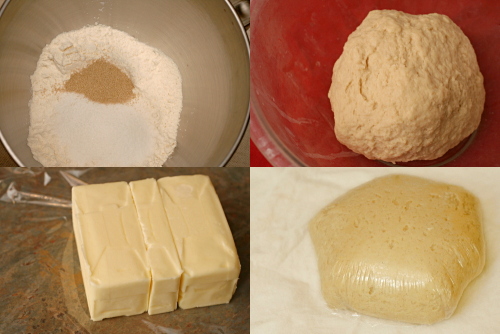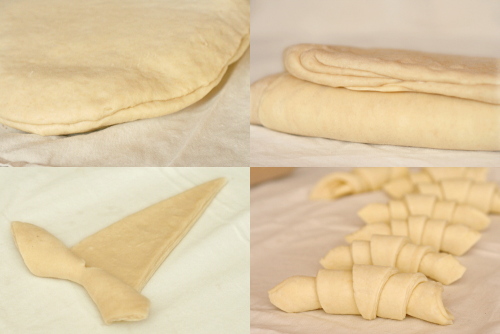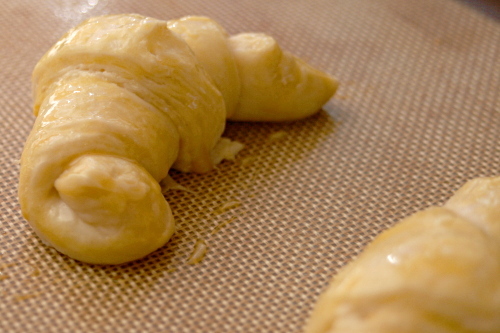I worked in a lab for years, but I never absolutely loved it. You’d think I would have, considering that I basically mixed up ingredients and baked them, but I guess without that crucial eating-the-batter – sorry, of course I mean that eating-the-result step, it just wasn’t as fun.
Plus I could never get the hang of keeping good records in the lab. My notebook seemed to be both unorganized and lacking crucial information. I took detailed notes on the amount and type of ingredients used and the baking temperature and time, but whenever I needed to look up details of the result, I was left with a few marginally descriptive words.
In the kitchen, it’s the opposite. The result, now that’s memorable, especially in this case – slightly sweet, intensely flaky, dark golden brown, impossible to resist, always leaving me wanting another.
The path to that result isn’t as memorable, particularly in the amount of instant dry yeast I used. Probably I should have written that down somewhere. I’m going to hypothesize – remember, hypothesizing is not the same thing as guessing! It’s an educated guess, which is to say, don’t skip out on this recipe just because the fresh yeast called for in the original recipe is dumb and I’m bad at note-taking, because the chances are very good that my estimate of the amount of yeast I used isn’t too terribly terrible, and anyway, it’s yeast and yeast always does its job eventually.
Anyway. I’m going to hypothesize that I used about one packet of yeast. Please accept my apologies for not taking thirty seconds to write it down. This must be why I now have an office job instead of a lab job.
One year ago: Anadama Bread
Two years ago: Baba Ghanoush and Falafel
Printer Friendly Recipe
Croissants (adapted from Martha Stewart’s Baking Handbook)
Makes 12
1 cup cold milk
1 tablespoon honey
14 ounces (about 3 cups) all-purpose flour
¼ cup (1.75 ounces) sugar
2¼ teaspoons salt
2¼ teaspoons (1 packet) instant yeast
20 tablespoons (2½ sticks) unsalted butter, cold
1 large egg, lightly beaten with a pinch of salt and a dribble of water or milk
1. Make the dough package: Pour the milk and honey into a 2-cup liquid measuring cup, and stir to combine; set aside. In the bowl of an electric mixer fitted with the dough hook, stir together 12 ounces (about 2¾ cups) of the flour, the sugar, yeast, and salt; stir to combine. Add the milk mixture and mix on low speed until the dough just comes together, 2 to 3 minutes.
2. Turn out the dough onto a lightly floured work surface; gently knead to form a smooth ball, about 45 seconds. Wrap in plastic and refrigerate at least 1 hour or overnight.
3. Make the butter package: Lay the butter sticks side by side on a piece of plastic wrap, and sprinkle with the remaining 1 ounce (about 2 tablespoons) flour. Pound with a rolling pin until the flour is incorporated; roll into a 4- by 3-inch rectangle. Wrap tightly and refrigerate for at least 1 hour or overnight.
4. Remove the dough package from the refrigerator; place on a lightly floured work surface. Roll out to an 8-by-10-inch rectangle, about ½ inch thick, with a short side facing you. Remove the butter package from the refrigerator; place on the bottom half of the dough; fold the top half of the dough over the butter, and pinch the edges to seal.
5. Roll out the dough to a 10-by-10-inch square about ½ inch thick; keep the corners as square as possible. Remove any excess flour with a dry pastry brush. Starting at the far end, fold the square in thirds, as you would a business letter. This completes the first of three turns. Wrap in plastic and refrigerate for 1 hour.
6. Repeat rolling and folding as above two more times, starting with the flap opening on the right, as if it were a book, and refrigerate at least 1 hour between turns. To help you remember how many turns have been completed, mark the dough after each: Make one mark for the first turn, two for the second, and three for the third. After the third, wrap the dough in plastic, and refrigerate 6 to 8 hours, or overnight.
7. Turn out the chilled dough onto a lightly floured work surface. Roll out the dough to a 30-by-8-inch rectangle. (If the dough becomes too elastic, cover with plastic wrap, and let rest in the refrigerator for 10 minutes.) Using a pizza wheel, cut the dough into triangles, each with a 4-inch base (you will have scraps of dough at both ends). Cut a 1-inch slit in the center of the base of each triangle. Place triangles in a single layer on a clean work surface.
8. To shape the croissants, stretch the two lower points of each triangle to enlarge the slit slightly. Fold the inner corners formed by the slit toward the outer sides of the triangles, and press down to seal. Using your fingertips, roll the base of each triangle up and away from you, stretching the dough slightly outward as you roll; the tip should be tucked under the croissant. Pull the two ends toward you to form a crescent. Transfer the crescents to a parchment-lined baking sheets, 2 inches apart. Cover loosely with plastic wrap, and let rise in a warm place until very spongy and doubled in bulk, 45 to 60 minutes.
9. Preheat the oven to 400ºF, with a rack in the middle position. Lightly brush the crescents with the beaten egg. Bake until the croissants are puffed and golden brown, about 15 to 20 minutes. Transfer the sheet to a wire rack to cool. Serve warm or at room temperature.












Gorgeous croissants! One day I’ll work up the courage to roll a huge chunk of butter into a ball of dough. It’s definitely on my list of things to do since they’re one of my most favorite breakfast (or anytime) treats!
Gah, you’re killing me with posts like these when I have no oven! But here’s the question – was this recipe better than the tartine one? It looks like it got better results, but you didn’t explicitly say. And hey, if you’ll go through the recipe testing for me, that just makes my route to croissant happiness a wee bit shorter 🙂
these croissants look gorgeous. It’s been a long time since I have made laminated dough. I may have to try out this recipe.
These are gorgeous! Wonderful colour and flakiness. 🙂 I love croissants… maybe because they involve copious amounts of butter? 😉
Wei-Wei
I am trying reeeeeally hard to convince myself that almost 2 tablespoons of butter per croissant isn’t that bad. Maybe I could make mini croissants. And only eat one. Hahahaha.
These look beautiful!! I have been wanting to make these for awhile, but for some reason am scared. I will have to try them soon.
Haven’t you been on a croissant mission for awhile now? Is this the ultimate recipe?
Very impressive! These look so scrumptious and flaky… I’ll have to buck up and give these a try!
These look amazing! I really want to try them! Maybe I can make a gluten free version 🙂
Just a beautiful beautiful job. I promised myself I would take on croissants by my 40th birthday and I am just about 6 weeks away so I need to get to it. Is it hard? Scary? I feel like I need someone to hold my hand through it all…
Love croissants…don’t make them often though, because I love them waaayy tooo much! ;-D
The pics are very helpful though in describing what you did…even without the exact yeast info!
Caitlin, Branny – I haven’t chosen a favorite recipe by any means. I have at least one more I want to try, and then I want to make the Tartine recipe again. Something went wrong the first time I made it, which was also my first attempt at croissants.
Dana – Croissants aren’t really hard, but, yes, I do think they’re scary for the first time. 🙂 Just like any new technique.
Everyone who is afraid of all the butter – My trick for limiting myself to one croissant is to freeze the dough after the croissants are shaped. Then I let them defrost and rise overnight and bake them when I wake up. I only defrost two at a time, so unless I eat Dave’s before he wakes up and conveniently forget to tell him that there were croissants, I’m stuck with just one.
Wow! These look amazing!!!
They look so perfect! Golden and brown. I’ve always been afraid of learning to make them. Not because of any difficulty, but because I want my pants to keep fitting!
Bridget, you’re a genius! Do you let them thaw/rise on the counter overnight or in the fridge?
katie – I let them thaw and rise overnight at room temperature.
These look amazing!!
I have read this recipe like 10 times and I am finally courageous enough to try, I don’t know why I am so nervous making croissants, but I am.
I have a question at step #4, it says to roll out to an 8 x10 inch rectangle and place the butter package on the bottom half. But the butter package is an 8×8, do you mean to roll out dough to 18×10? And do you really refrigerate it overnight twice? Thanks so much!
Debbie – In step four, roll the butter out to a 4- by 8-inch rectangle, not an 8-inch square. That’s corrected now. As far as refrigerating overnight goes, it doesn’t look like the first chill needs to be quite that long. It will probably depend mostly on how the timing works for you.
Thanks for your take on this recipe. I’m in the middle of the recipe from Martha’s baking book and I was trying to convert the fresh yeast in oz. to dry yeast and I found your blog. I figured it would be 2 1/2 pkgs for the original recipe which makes 24. But I’m also dealing with High Altitude being in Colorado…..so I’ve decreased it to 2 pkg. I’m letting it rest for the night and (hopefully) we will enjoy them for New Years Day.
Your pictures are amazing.
Happy New Year.
Soon the fireworks go off of Pikes Peak and I’m going to brave the 0 degree weather to watch them in town with champagne.